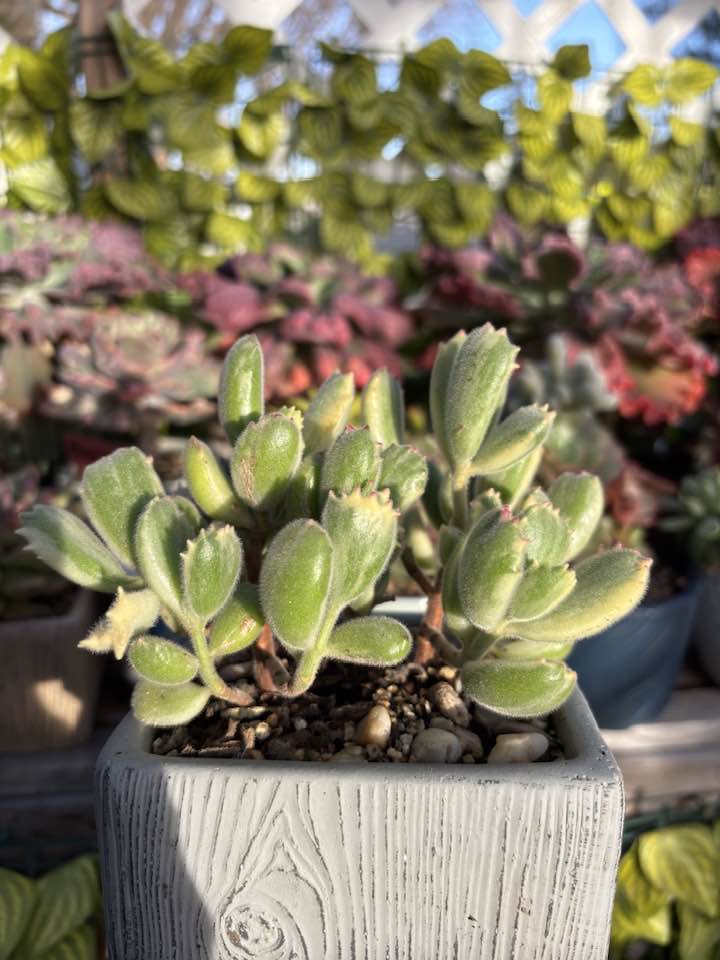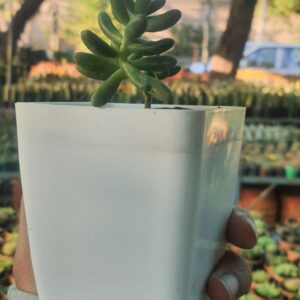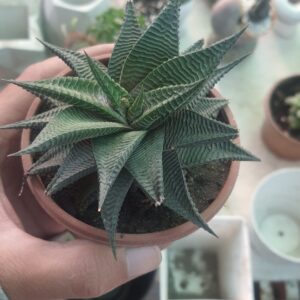Bear Paw Variegated – Cotyledon tomentosa variegata
With its fleshy, fuzzy leaves that look like bear claws, the beautiful, slow-growing succulent known as Bear Paw Variegated (Cotyledon tomentosa variegata) is popular. With creamy yellow or white marbling alongside green, this variegated form has a distinctive, ornamental appearance. This succulent, which is native to South Africa and a member of the Crassulaceae family, is well-liked by succulent collectors for its endearing look, fleshy leaves, and smooth, velvety texture.
It needs more care than the typical green Bear Paw due to its unique variegation and delicate disposition, but it rewards producers with an absolutely gorgeous plant.
🌿 Botanical Overview
Scientific Name: Variegata tomentosa cotyledon
Family: Crassulaceae
Popular names include Variegated Bear Claw and Bear Paw Variegated.
South Africa is where it comes from.
Habit of growth: a dense, succulent shrub
Size:
Max. height: 12 inches (30 cm)
Width: 18 inches (45 cm) when fully grown
🍃 Look
Foliage:
fat, ovate, and plump leaves with a soft, velvety, or fuzzy feel
The ends of the leaves have tiny teeth, like a bear’s paw.
Cream, light yellow, or white streaks and areas are examples of variegation.
When exposed to bright light, leaf tips may become red or pink.
Flowers:
orange to coral red blooms that are bell-shaped in the spring or early summer
Flowers bloom on erect stems above the leaves.
Needs for Illumination
Inside:
Requires 5–6 hours of strong, indirect sunlight every day
The best orientation for a window is south or east.
Variegated leaves can be burned by direct strong afternoon sunlight.
Outside:
likes morning sun with afternoon shade
Non-variegated types are less susceptible to sunburn than variegated ones.
The variegation and reddish leaf tips are accentuated by the brilliant, filtered sunlight.
Humidity and Temperature
Temperature:
Ideal range: 18–27°C (65–80°F)
Avoid exposure below 5°C (41°F) since it is not frost-tolerant.
Bring the plant inside if the outdoor temperature gets lower.
Humidity:
Grows well in low to moderate humidity
The likelihood of contracting fungal illnesses can be increased by excessive humidity.
Maintaining healthy, rot-free foliage requires good air movement.
💧 Watering Schedule
Spring to Autumn (The Growing Season):
Water thoroughly when the top 2 inches of soil are dry
In general, the interval is between 10 and 14 days, taking into account the indoor environment.
Use the soak and dry approach, making sure there is no standing water in the pot.
Winter (Dormancy):
Water sparingly, about once every three to four weeks.
Because leaves store water, it is safer to water less often.
Root rot and leaf drop are mainly brought on by excessive watering, especially in variegated forms.
🌱 Soil Needs
Kind:
Requires soil that is conducive to the growth of cacti and succulents and that drains effectively.
Optimal combination:
half cactus mix
25% pumice or perlite
25% coarse sand
pH: Between neutral and mildly acidic (6.0 to 7.0)
To avoid soggy soil, always use pots that have drainage holes.
🌾 Fertilizing
Feed during the spring and summer (the time of active growth).
Once every four to six weeks, apply a diluted cactus/succulent fertilizer.
Stay away from fertilizers with a lot of nitrogen, as they can promote leggy growth.
Autumn and winter are not feeding periods.
✂️ Upkeep & Pruning
Take out:
leaves that are dried up or dead
Flower stalks after blooming
Light pruning can encourage branching and help preserve shape.
To prevent breaking the delicate, thick leaves, handle them with care.
🌿 Propagation
Stem Cuttings:
The best technique is to plant in dry soil after cutting a healthy stem and letting it callous for a few days.
After a week, when the roots begin to develop, water lightly.
Leaf Cuttings:
Although possible, stem cuttings are less effective.
Offsets:
Sometimes, offsets are formed at the base that may be separated.
Common Issues
Excessive watering leads to root rot, leaf yellowing, and mushiness.
Underwatering: Leaves that are wrinkled and shriveled
Mealybugs, spider mites, and aphids are among the pests that may strike.
Sunburn: Excessive exposure to direct sunlight causes brown, crunchy spots to form on variegated leaves.
Keep up a regular watering routine and treat pests with neem oil or insecticidal soap.
⚠️ Toxicity
If consumed, it is harmful to pets.
Keep it away from dogs, cats, and kids.
🎍 For ornamental purposes
Ideal for:
Displays of succulents indoors
Window or shelf plants
pots for decoration
lush bouquets
Because of its plump, vibrant leaves, it is a surefire conversation starter in any collection.
Conclusion
The Bear Paw Variegated is a lovely but somewhat fragile succulent that does well in well-draining soil, bright light, and careful watering. Its creamy variegation on its fuzzy, claw-like leaves gives your plant collection a touch of beauty and individuality.
Office Plants, Succulents
Bear Paw Variegated
₨799.00
Bear Paw Variegated
A colorful twist on the Bear Paw, featuring cream and green paw-shaped fuzzy leaves—charming and unusual with high collector appeal.





Reviews
There are no reviews yet.